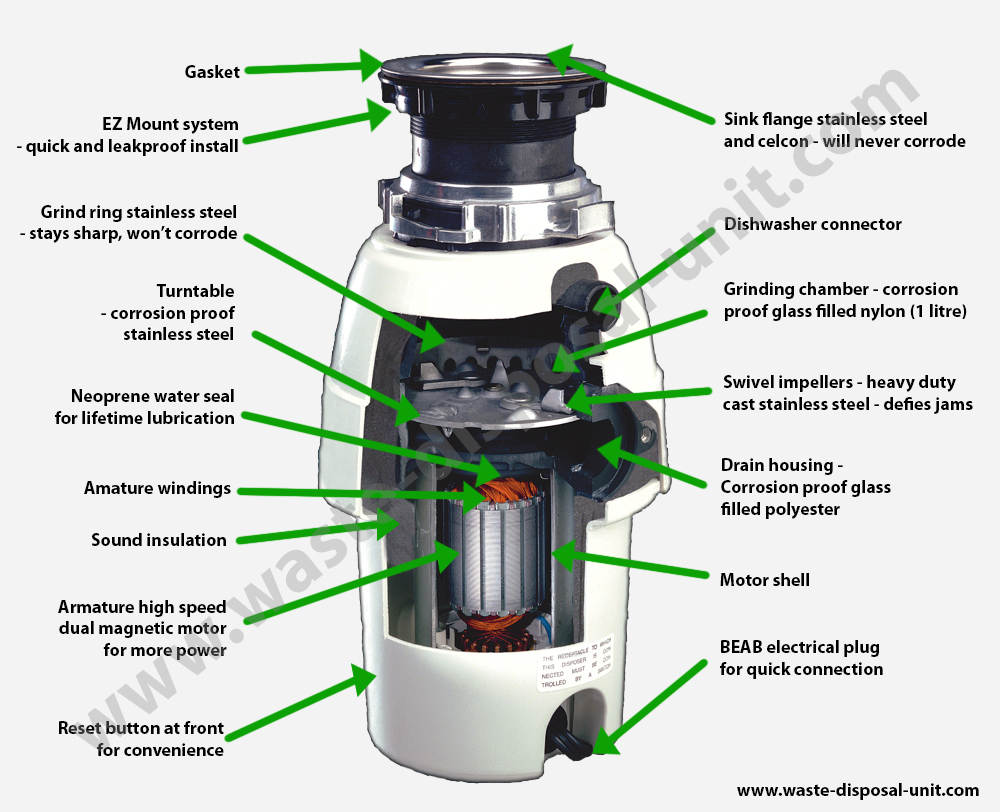Take A Look Inside a Waste Disposal Unit
Operation

Waste disposers are cylindrical units that are easily fitted under the kitchen sink and need to be connected to an electricity supply and connected in to the waste pipe. They quickly grind kitchen food waste into miniscule particles (less than 2mm) and flush them into the waste water system, to be treated with the rest of the sewage. Driven by a high speed electric motor they are easy and completely safe to use. Since the Waste King has permanent magnets to get the turntable up to maximum speed within the first revolution there is an intense torque – or grinding – power hitting the waste which literally pulverises it without jamming (not the case with lower speed designs or induction magnet motors such as Insinkerator). The motor and the turntable are perfectly balanced to eliminate any unnecessary vibration.
With the cold water running at full flow food waste is scraped of the plate and pushed into the feed chamber by hand or a small brush where it hits a revolving spinning turntable. The grinder has no knives or blades and so are safe to operate. Instead they use swinging impellers mounted on the turntable use centrifugal force to continuously force food waste particles against a stationary grind ring.
Designed to be safe and avoid jams
The impellers swing so as to avoid jamming of the food – before this innovation costly food used to get jammed between the impeller and grinding ring which led to the introduction of complex reversing motors to get around it. Now these are considered as over-kill and a source of breakdown since having complex electronic circuitry on a unit that vibrates when used is asking for trouble! On cheaper brands the impellers are just pressed stainless steel (sometimes not even stainless) whereas on Waste King they are made from cast stainless steel for maximum strength and longevity. This is a key safety feature for Waste King since some cheaper brand’s impellers have been known to break off and fly out injuring people. The impellers fling the waste against the grinding ring which breaks down the food waste into very fine particles – virtually liquefying them. Once they are ground the running water flushes the particles through the grind ring into the waste water pipe. If something metal – such as a piece of cutlery – enters the chamber then the impellers will ping against it and are designed to not jam from a few seconds contact – enough time for it to be turned off. If it is left too long or does jam then a power overload kicks in which stops the motor necessitating the removal of the metal object and pressing the reset button. The removable splash guards mean it is easy to look into the unit to see what has happened. Always isolate the power and never put your hand inside the disposer whilst it is running.
Low energy and water use
Food waste disposal units are typically rated between 1/2-1 hp (0.3–0.7 kw). They only need a very short run time so their energy and water use is minimal. DEFRA has estimated that on average food waste disposers run for just over 15 seconds per use and use just 2-3 kWh of electricity a year. At current average electricity prices this represents a cost of approximately 37 pence p.a. A disposal unit’s average water consumption is only 0.07% of a household’s annual use, or the equivalent of about one extra toilet flush a day.
What can I put down it?
Pretty much any kitchen waste apart from really stringy stuff. Fruit and vegetable peelings, husks, plate scrapings, any liquids (not hot fat unless it has a good dose of washing-up liquid mixed in first), fish bones, poultry bones but not beef or lamb but waste meat is ok. Some big pieces of waste like pineapple branches need to be sliced into 2 or 4 before putting down, eggshells are fine and are good to clean out and scour the waste pipework of any build up of fatty deposits.
User Instructions
The cold water tap needs to be running on full before you start the unit and run for 20 seconds after it completes so that everything is fully flushed away. For safety reasons don’t put your hands into the unit or below the rubber sink guard but use a small brush. If you drop anything metal into it then stop it immediately. If the food is not being ground properly, eg you have forgotten to turn on the water and say an apple has just clogged up the turntable then just turn it off and using the brush move it around a bit and then turn it back on which should enable it to continue working properly. Alternatively put something thicker into it such as a fruit husk or orange peel and/or a jug of water to help get it moving again.
Maintenance
The unit shouldn’t need any maintenance. If you regularly put citrus peel down it that will keep it clean and degrease it. You can also put a jug of ice-cubes down from time to time to help clean off any solids that might have built up over time, egg shells will help this too.
